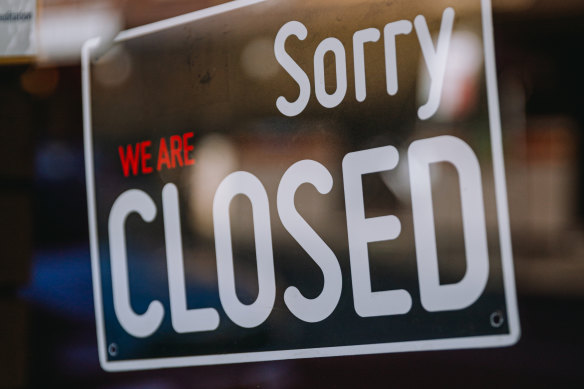This was published 1 year ago
Taylor Swift gave retail a boost, showing up the rest of the economy
By Shane Wright
Not even a blast of spending from Taylor Swift fans in the nation’s two largest states can shake off growing signs the economy is slowing and the jobs market deteriorating as interest rates, inflation and tax hit Australians’ bottom line.
Figures on Thursday showed subdued retail sales results for everywhere except NSW and Victoria, the seventh consecutive quarterly fall in job vacancies across the country and a further lift in the number of businesses being forced into administration.

Craft and clothing stores in Sydney and Melbourne benefited from Taylor Swift’s concerts, but the rest of the economy missed out.Credit: Getty
The Australian Bureau of Statistics said the value of retail sales rose by a less-than-expected 0.3 per cent in February, with almost all the growth associated with Swift’s seven-concert tour of Sydney and Melbourne last month.
Clothing and footwear sales lifted by 4.2 per cent, while they grew by 2.3 per cent through department stores.
“Fashion and accessory retailers told us offerings of Taylor Swift-inspired outfits and related do-it-yourself accessories added to turnover in February,” said the bureau’s head of retail statistics, Ben Dorber.
But spending fell for household goods (down 0.8 per cent), other retailing (0.4 per cent) and food (0.1 per cent). Retail sales in Victoria climbed by 0.7 per cent, while they were up by 0.6 per cent in NSW. But they fell 0.5 per cent in Swift-less Queensland.
Longer term, retail sales have increased by 1.6 per cent in the year to February. Over the same period, inflation was up by 3.4 per cent, suggesting that in real terms the value of retail sales had fallen.
Separate figures from the bureau showed job vacancies in the three months to the end of February fell by 6.1 per cent to be 17.7 per cent lower over the past year.
Job vacancies peaked at 475,400 in the May quarter of 2022. At the time, the national workforce was 14 million people.
Since then, the workforce has grown by 830,000 to almost 14.9 million, while the number of vacancies has fallen by 23 per cent to 363,800.
The proportion of businesses with vacancies has fallen from 27.3 per cent in late 2022 to 18.3 per cent. Vacancies are lowest in Queensland and Tasmania, while the proportion of NSW firms with vacancies has dropped from almost 29 per cent to 18.5 per cent.
Insolvency figures compiled by the Australian Securities and Investments Commission also show the troubles facing the business sector.
Through the first seven months of the 2023-24 financial year, external administrators were appointed to 6610 businesses – up 36.1 per cent on the same period of the last financial year.
On current trends, administrator appointments will be more than 10,000 this year. The last time it was this high was in 2012-13 when businesses, supported by government stimulus through the global financial crisis, started to falter.

More stores are closing and installing administrators as the economy struggles.Credit: Dion Georgopoulos
AMP deputy chief economist Diana Mousina said the figures pointed to headwinds facing the economy that would ultimately force the Reserve Bank into cutting official interest rates in the second half of this year.
“The data indicates that the weakness in the retail environment has continued into early 2024,” she said.
“While one-off events like sport or concerts can cause a temporary rise in retail spending, it isn’t strong enough to offset the broader pressures on the consumer of high interest rates, elevated (albeit slowing) inflation and the increasing tax burden from bracket creep.”
Shannon Nicoll, associated economist with Moody’s Analytics, said taken with this week’s inflation figures, which showed monthly inflation steady for a third consecutive month at 3.4 per cent, the data pointed to a rate cut later this year.
“High borrowing costs are keeping Aussie households from spending with any exuberance,” he said. “We expect borrowers will get some relief in September.”
Cut through the noise of federal politics with news, views and expert analysis. Subscribers can sign up to our weekly Inside Politics newsletter.